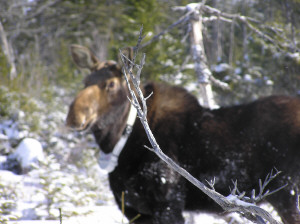 The word moose comes from the Algonquin Indians“ mooswa meaning “twig-eater” or “the animal that strips bark off of trees.” Through the years, it eventually changed into “moose.”
The word moose comes from the Algonquin Indians“ mooswa meaning “twig-eater” or “the animal that strips bark off of trees.” Through the years, it eventually changed into “moose.”
For Mi’kmaq people the moose is an important animal. supplying us with food and other things for our survival. Moose meat is a source of nourishment during the long winters. The hide was used to make clothing and provide shelter, and moose bones and antlers were shaped into useful tools.
The moose is the world’s largest deer. The moose can run 35 miles per hour and can easily swim 10 miles.
Moose eat willow, birch and aspen twigs, horsetail, sedges, roots, pond weeds and grasses. Moose eat leaves, twigs, buds and the bark of some woody plants, as well as lichens, aquatic plants and some of the taller herbaceous land plants. They can actually feed under water.
Moose are found in northern forests in North America, Europe, and Russia. In Europe and Asia, moose are called elk.
Hooves are the first line of defense! While a male may use its antlers to hold off a predator, a moose’s sharp hooves are its first line of defense. Moose are able to kick out in all directions, but generally use their front feet.
They’re faster than they look! A moose’s long legs allow it to move easily over rough terrain and through deep snow. A moose can run almost as fast as a horse, or about 30 miles per hour for a short time period.
Moose live for a long time. Cow moose have been known to live for as long as 20 years. Bull moose may reach 15 years of age.
Information from www.moosefoundation.org
